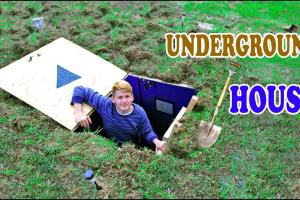Ultimate Guide to Building Your Own Underground House

-
Quick Links:
- Introduction
- Benefits of Building Underground
- Designs for Underground Houses
- Planning Your Underground House
- Materials for Construction
- Step-by-Step Construction Process
- Case Studies
- Expert Insights
- FAQs
Introduction
Building an underground house can be a unique and rewarding endeavor. With the increasing interest in sustainable living and eco-friendly construction, underground homes have gained popularity. These homes, also known as earth-sheltered or subterranean houses, provide excellent insulation, reduced energy costs, and minimal environmental impact. In this guide, we will take you through the entire process of building an underground house, from the initial planning stages to the final construction.
Benefits of Building Underground
There are several advantages to building an underground home:
- Energy Efficiency: Underground homes maintain a stable temperature, reducing heating and cooling costs.
- Noise Reduction: The earth acts as a barrier against external noise, ensuring a peaceful living environment.
- Environmental Impact: These homes have a smaller footprint and are less intrusive to the landscape.
- Safety: Underground homes offer protection from extreme weather events, such as tornadoes or hurricanes.
- Unique Aesthetics: The design possibilities are vast, allowing for creative and innovative layouts.
Designs for Underground Houses
When designing an underground house, there are various styles to consider:
- Completely Subterranean: These homes are built entirely below ground with earth covering the roof.
- Earth-Sheltered: Partially below ground, these homes often feature large windows or skylights for natural light.
- Earth Bermed: Built on a slope, these homes are partially above ground and use earth to insulate the structure.
Planning Your Underground House
Proper planning is crucial when constructing an underground house:
- Choose the Right Location: Look for areas with stable soil and good drainage to avoid water issues.
- Consult Local Building Codes: Ensure your plans comply with local regulations regarding underground structures.
- Design for Natural Light: Incorporate windows or light wells to bring in sunlight.
- Plan for Ventilation: Proper airflow is essential to ensure a healthy living environment.
Materials for Construction
The materials you choose for your underground house play a vital role in its durability and efficiency:
- Concrete: Ideal for walls and ceilings due to its strength and insulation properties.
- Insulation: Use quality insulation materials to enhance energy efficiency and comfort.
- Waterproofing Membrane: Essential for preventing moisture ingress.
- Windows: High-quality, energy-efficient windows are critical for natural light and insulation.
Step-by-Step Construction Process
Here’s a detailed step-by-step guide to help you build your underground house:
- Site Preparation: Clear the land and excavate the area for the structure.
- Foundation: Pour a solid concrete foundation that can withstand earth pressure.
- Walls and Ceiling: Construct walls with reinforced concrete, ensuring proper insulation.
- Waterproofing: Apply a waterproof membrane to protect against moisture.
- Ventilation System: Install a proper ventilation system to maintain air quality.
- Interior Finishing: Finish the interior with your desired materials, including flooring and walls.
- Landscaping: Reintegrate the earth around the house for a natural look.
Case Studies
Let’s take a look at some successful underground house projects:
Case Study 1: The Earth House
A couple in Vermont built a completely subterranean home that blends seamlessly with the landscape. They used reclaimed materials and solar panels, showcasing how sustainable living can be achieved underground.
Case Study 2: The Hill House
This partially above-ground house in Oregon features large windows and a green roof, providing excellent insulation and aesthetics. The owners report significant savings on energy bills.
Expert Insights
Experts recommend considering the following when building an underground house:
- Soil Testing: Conduct soil tests to ensure stability and drainage.
- Professional Help: Engage architects and builders experienced in underground construction.
- Future Proofing: Plan for changes in climate and environment over the years.
FAQs
1. Are underground homes safe?
Yes, underground homes are designed to withstand extreme weather and are often safer than traditional houses.
2. How do I ensure proper ventilation?
Install a mechanical ventilation system to maintain airflow and prevent moisture buildup.
3. What are the costs involved in building an underground house?
Costs can vary significantly based on design, materials, and location, but they tend to be comparable to traditional homes.
4. Can I get natural light in an underground house?
Yes, by incorporating windows, light wells, and skylights, you can achieve ample natural light.
5. What materials are best for insulation?
High-quality foam insulation or rigid insulation boards are recommended for their thermal resistance.
6. How long does it take to build an underground house?
The timeline can range from several months to over a year, depending on complexity and weather conditions.
7. Are underground homes energy-efficient?
Yes, they are extremely energy-efficient due to the natural insulation provided by the earth.
8. What are common challenges in building underground homes?
Common challenges include moisture management, ventilation, and compliance with building codes.
9. Can I finance an underground house?
Financing options are similar to those for traditional homes; however, some lenders may require additional documentation.
10. Is it possible to build an underground house myself?
While DIY is possible, it’s advisable to consult professionals for structural and safety aspects.
Random Reads
- How to use hindi keyboard on whatsapp
- How to use gparted
- How to download minecraft maps
- How to download minecraft for free
- How to shoot dice
- How to show hidden files and folders on a mac
- Unlock android phone without factory reset
- How to choose a good xbox gamertag
- 10 easy ways to shorten url
- How to download videos using real player